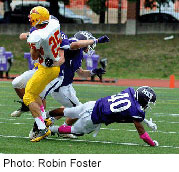- Stigma, Shame Hit Many Gay Men Affected by Mpox Outbreak
- Calories, Not Meal Timing, Key to Weight Loss: Study
- Dietary Changes May Beat Meds in Treating IBS
- Screen Pregnant Women for Syphilis, Ob-Gyn Group Advises
- Even With Weight Gain, Quitting Smoking in Pregnancy Still Best for Health
- A-Fib Is Strong Precursor to Heart Failure
- One Neurological Factor Keeps Black, Hispanic Patients From Alzheimer’s Clinical Trials
- Managing Blood Sugar After Stroke Could Be Key to Outcomes
- Dozens of COVID Virus Mutations Arose in Man With Longest Known Case
- Blood Test Might Someday Diagnose Early MS
Even Mild Hits to the Head Might Harm the Brain, Study Finds

As more research focuses on the damage concussions can cause, scientists now report that even mild blows to the head might affect memory and thinking.
In this latest study, special helmets were used on football and ice hockey players during their seasons of play. None of the players were diagnosed with a concussion during the study period, but the special helmets recorded key data whenever the players received milder blows to the head.
“The accelerometers in the helmets allowed us to count and quantify the intensity and frequency of impacts,” said study author Dr. Tom McAllister. “We thought it might result in some interesting insights.”
The researchers found that the extent of change in the brain’s white matter was greater in those who performed worse than expected on tests of memory and learning. White matter transports messages between different parts of the brain.
“This suggests that concussion is not the only thing we need to pay attention to,” said McAllister, chairman of the department of psychiatry at the Indiana University School of Medicine. “These athletes didn’t have a concussion diagnosis in the year we studied them … and there is a subsample of them who are perhaps more vulnerable to impact. We need to learn more about how long these changes last and whether the changes are permanent.”
The study was published online Dec. 11 in the journal Neurology.
Concussions are mild traumatic brain injuries that occur from a sudden blow to the head or body. Symptoms include headache, blurry vision and difficulty sleeping or thinking clearly. Research on repetitive brain impacts not associated with diagnosed concussions is sparse and contradictory, the researchers said.
McAllister, who conducted the research while affiliated with Dartmouth College, compared 80 concussion-free varsity football and ice hockey players wearing specialized helmets to 79 athletes in noncontact sports. He evaluated them before and after the season with brain scans and learning and memory tests.
A total of 20 percent of the contact-sport players and 11 percent of the noncontact athletes performed worse on a test of verbal learning and memory at the end of the season, a decline expected in less than 7 percent of a normal population, McAllister said. Those performing worse exhibited more changes in the corpus callosum region of the brain — a bundle of nerves connecting the left and right sides of the brain — than athletes who scored as predicted.
Dr. Howard Derman, co-director of the Methodist Concussion Center in Houston, said he wasn’t surprised by the findings. He said blows to the head without a reported concussion might cause brain damage that doesn’t produce symptoms.
Derman said future research on this topic would be illuminating if, with specially equipped helmets, blood flow and pressure changes in the brain could be measured during repetitive head blows.
“If you can document that there are changes to the brain and there haven’t been significant blows, it would be even more of a concern,” he said. “We have to assume there is some cumulative effect, with multiple blows causing the problem. It’s like bending a piece of plastic once — nothing happens. But if you do it 40 times, you break the plastic.”
More information
Visit the American Academy of Neurology for more on concussions.
Source: HealthDay
Copyright © 2024 HealthDay. All rights reserved.










